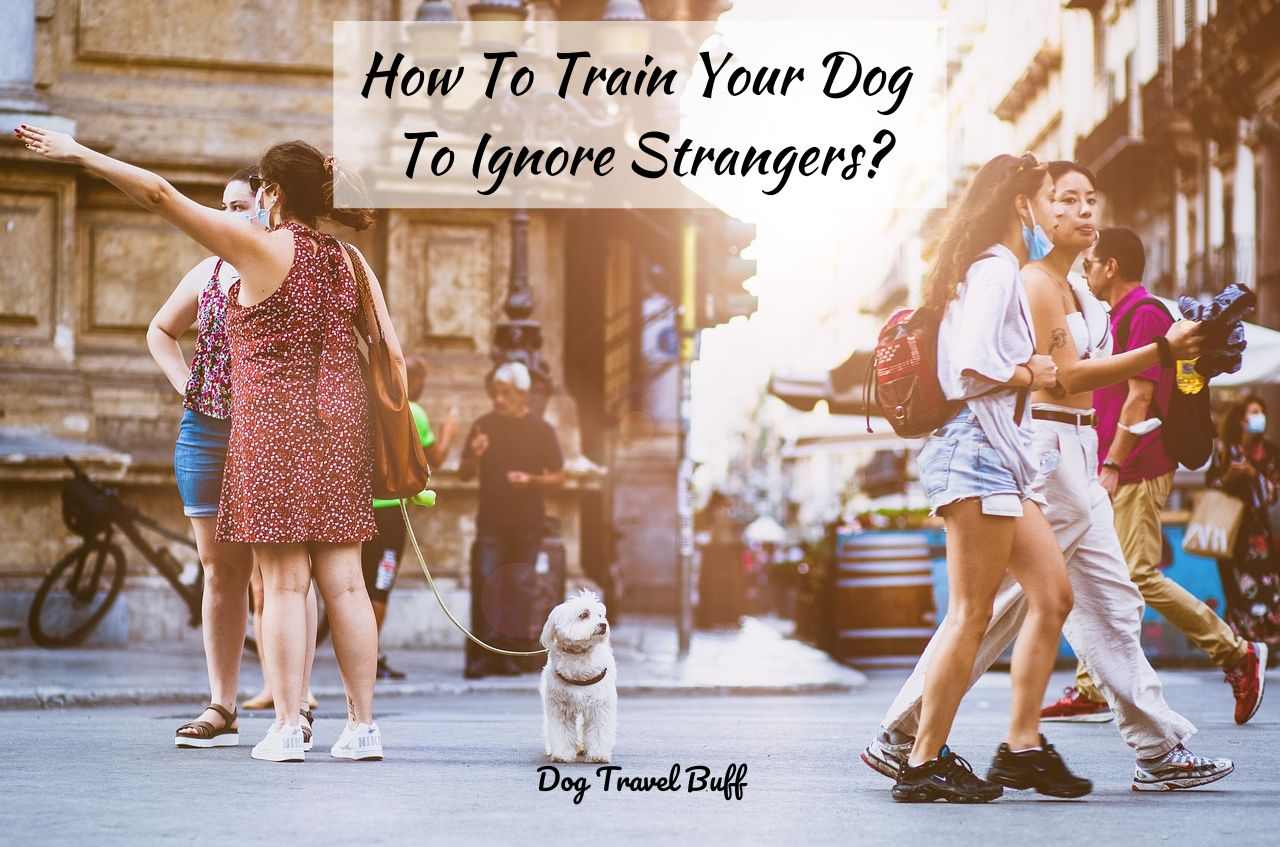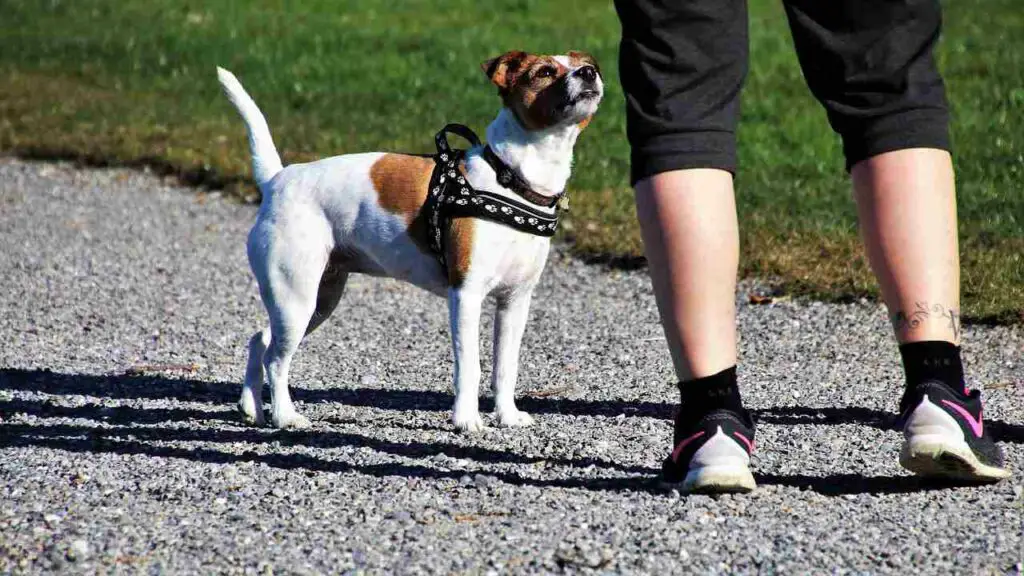How To Train Your Dog To Ignore Strangers– Easy Guide & Tips
Training a dog to ignore strangers involves socialization and obedience training. Start by introducing your dog to unfamiliar individuals in a safe setting, and reinforce positive behavior. To divert your dog’s attention away from strangers, use orders like “leave it” or “stay”. Your dog can learn to ignore people from strangers with consistent training and positive reinforcement.
Training your dog to ignore strangers is not only crucial for their safety and the safety of others, but it can also improve their overall behavior and obedience. So, do you wonder how to train your dog to ignore strangers?

This post may contain affiliate links. If you buy something through one of those links, you won’t pay any extra penny, but I’ll get a small commission that encourages me to deliver more helpful content for you.
Dogs are beloved companions and loyal protectors. Their instinct to guard their owners and territory is an innate trait honed over centuries of domestication. However, this protective instinct can sometimes manifest as aggression towards strangers, making socializing your dog or taking them out in public difficult.
In this article, I’ll discuss effective techniques and tips I used to train my dogs to ignore strangers, and it worked just fine.
Table of Contents
Understanding Your Dog’s Behavior
Before I dive into the training techniques, it’s essential to understand the root cause of your dog’s behavior toward strangers. Different types of aggression can stem from fear, territorial instincts, lack of socialization, and genetic predisposition.
Some dogs may become aggressive out of fear or anxiety, while others may perceive strangers as a threat to their territory and react accordingly.
If you find your dog barking, snarling, biting, or even hiding behind you after seeing an unknown person, these are the clear signs of fear and aggression. It’s essential to identify these behaviors early on and take steps to address them. Ignoring or allowing the problem to escalate can be dangerous for your dog and those around them.
Preparing Your Dog for Training
Before training your dog to ignore strangers, you must prepare the right tools and environment. Dogs can be too aggravated sometimes; mine was a lot, so getting geared up is a good precaution. A few essential items include a sturdy leash and collar, treats or rewards, and a designated training space free from distractions.
It’s also crucial to assess your dog’s current level of obedience. If your dog is still learning basic commands such as “sit,” “stay,” and “come,” you’ll need to work on those skills first. A well-trained dog will be easier to manage during training and more likely to respond to your commands. But don’t worry, I worked out my way through the basics, and so can you.
Top 4 Effective Training Techniques
Having your dog together on a walk is a great experience, but it can also be a headache if it starts barking at pedestrians. I use these techniques to prevent my dog from doing so.
You can also stop your dog from barking at strangers on walks or at home by following them. These methods are easy to apply and require only continuous efforts from the dog and the owners.
1. Desensitization and Counter-Conditioning
Desensitization involves gradually exposing your dog to stimuli that trigger their fear or aggression, such as strangers. The goal is to decrease their sensitivity to these triggers by slowly introducing them in a controlled environment.
Counter-conditioning works in tandem with desensitization by associating the trigger with positive rewards, as in my case, treating my dog with biscuits; she loved it.
Desensitization and counter-conditioning are effective techniques to help dogs overcome fear or aggression towards specific stimuli, such as strangers. In my experience, it’s the easiest and fastest way to approach this odd deal. The repetitive cycle of training and reward even works for humans, and dogs love a free biscuit too.
This association helps dogs respond positively to the trigger, reducing fear or aggression. Together, these techniques can help your dog feel more comfortable and confident in previously stressful situations.
2. Positive Reinforcement Training
Positive reinforcement training is an effective way to train dogs by rewarding good behavior and ignoring bad behavior. Training my dogs to ignore strangers by reinforcing desirable behavior and avoiding punishment for undesirable behavior has been a success. So, if you wonder how to train your dog not to bite strangers, follow the instruction and train your dog to behave better.
To begin positive reinforcement training, start by introducing your dog to a stranger in a controlled environment, such as a training class or, in my case, the backyard.
When your dog approaches the stranger calmly and without aggression, reward the dog with treats or praise them. If your dog reacts aggressively, ignore the behavior and remove them from the situation.
Repeat this process, gradually increasing the level of exposure to strangers until your dog consistently responds calmly and positively.
3. Gradual Exposure to Strangers
My cousin’s brother was the sworn enemy of my dog. His presence alone makes my dog go wild. So I tried and asked my brother to visit me often and in a particular manner.
It worked. Gradual exposure to strangers is an effective technique for highly reactive dogs with severe aggression toward strangers. This technique involves exposing your dog to strangers in a controlled and gradual manner, starting with low-stress situations and slowly increasing the level of exposure.
I started gradual exposure training by introducing my dog to a stranger, “my brother,” at a distance where they were comfortable and calm. Over time, I gradually decreased the distance between my dog and him, rewarding my pet with treats or praise for remaining calm and not reacting aggressively.
As my dog became more comfortable with him, I increased its exposure to other strangers by introducing them to new people in different situations, such as walking on a busy street or visiting a crowded park.

4. Consistency and Repetition
Consistency and repetition are crucial in training your dog to ignore strangers. I made a mistake and left the training once my dog became obedient, but he was at it again a few days later.
So, set aside a regular training schedule and stick to it, even if progress is slow. Repetition is key to reinforcing good behavior and establishing positive habits.
During training, be consistent with your commands and rewards. Use the same verbal cues, such as “ignore” or “stay” and reward your dog consistently for good behavior. Over time, your dog will associate these cues with the desired behavior and respond accordingly.
Troubleshooting Common Issues While Training Dogs to Ignore Strangers
During the training process, you may encounter situations where your dog starts behaving abnormally; I experienced some. Such incidents are common during training and can be handled with little care. These issues can be addressed with the right techniques and strategies as follows.
1. Overcoming Fear and Anxiety
Dogs can experience fear and anxiety when introduced to new situations, but there are ways to help them overcome them. Create a safe and controlled training environment and use desensitization and counter-conditioning techniques to introduce them gradually to new stimuli. Positive reinforcement for calm behavior can also be helpful.
If you notice your dog growling at nothing, it can be a symptom of fear and anxiety. If your dog continues to display signs of fear and anxiety, consider consulting with a professional trainer or behaviorist. They can provide additional guidance and support to help your dog overcome their fears.
2. Addressing Aggressive Behavior
Do your dog barks at the wall too? It can indicate aggressive behavior in dogs, which is dangerous and requires immediate attention. If your dog displays such barking, growling, or biting, remove them from the situation or place immediately and seek professional help.
These incidents are a sign to take action, and things are getting out of hand. Professional trainers and behaviorists can help identify the root cause of your dog’s aggression and provide tailored training strategies to address it. In some cases, medication may also be recommended to help manage your dog’s behavior.

3. Dealing with Distractions and Setbacks
Distractions and setbacks are common during training, particularly in busy public environments. If your dog becomes distracted or reacts aggressively towards a stranger, remove them from the situation immediately and start again in a controlled environment.
Remember to be patient and persistent during the training process. Keep working with your dog, reinforcing good behavior and addressing issues as they arise.
4. Maintaining Good Behavior
Once your dog has learned to ignore strangers, it’s essential to maintain their good behavior. Reinforce positive behavior with treats and praise, and avoid situations that may trigger their aggression. It will also help train your dog to ignore other dogs and make morning walks easier.
Consistency is the key to maintain good behavior. Practice commands and reinforce positive behavior regularly, even after your dog has mastered the training.
Conclusion
Training your dog to ignore strangers is essential for their safety and those around them. Effective training techniques include desensitization and counter-conditioning, positive reinforcement training, gradual exposure to strangers, consistency, and repetition.
Remember to be patient and persistent during training, and seek professional help if necessary. With proper training, your dog can learn to ignore strangers and become a well-behaved and beloved companion, such as my friend here.
Read Next:
- Why Does My Chihuahua Lick So Much?
- What Results In Dog Fur Turning Rust Color? Easy Solution
- How To Potty Train A Yorkie In 2 Days
- How to Clean Dog’s Mouth After Eating Poop
FAQs
1. How do I stop my dog from reacting to strangers?
A: Teaching your dog to ignore strangers is essential in preventing aggressive reactions. Positive reinforcement techniques, including treats and praise, should reinforce good behavior and gradually introduce your dog to strangers in a controlled setting. Consistency and repetition are crucial for reinforcing positive behavior, and addressing any underlying issues like anxiety, or fear is important. Following these steps can help your dog learn to behave calmly around strangers.
2. Can a reactive dog be cured?
A: Yes, a reactive dog can be managed and trained to improve their behavior, but there is no cure for reactivity. Professional trainers and behaviorists can help identify the root cause of the behavior and provide tailored training strategies to address it. In some cases, medication may also be recommended to manage a dog’s behavior.
3. Why is my dog obsessed with strangers?
A: Dogs may be obsessed with strangers for various reasons, such as lack of socialization or training, fear or anxiety, or an instinct to protect their territory. Identifying the underlying cause of the behavior and addressing it with appropriate training techniques is essential.
4. What does it mean when a dog barks at a stranger?
A: Barking at a stranger can be a sign of aggression or fear. It’s essential to monitor your dog’s body language and behavior to determine the root cause of its reaction. Proper training and management can help address the behavior and prevent it from escalating into more severe issues.





